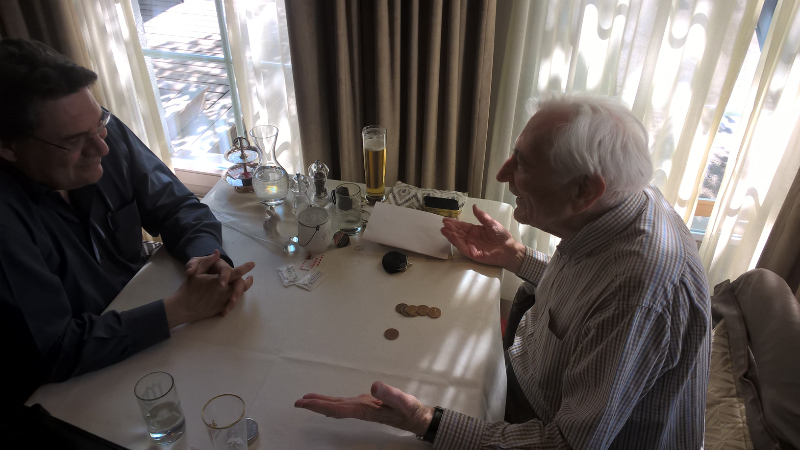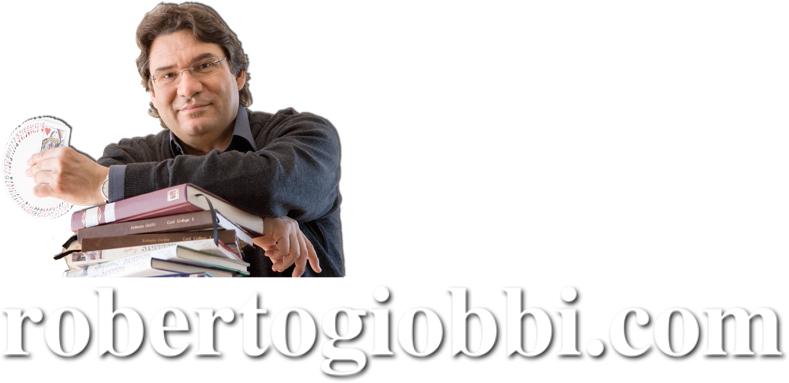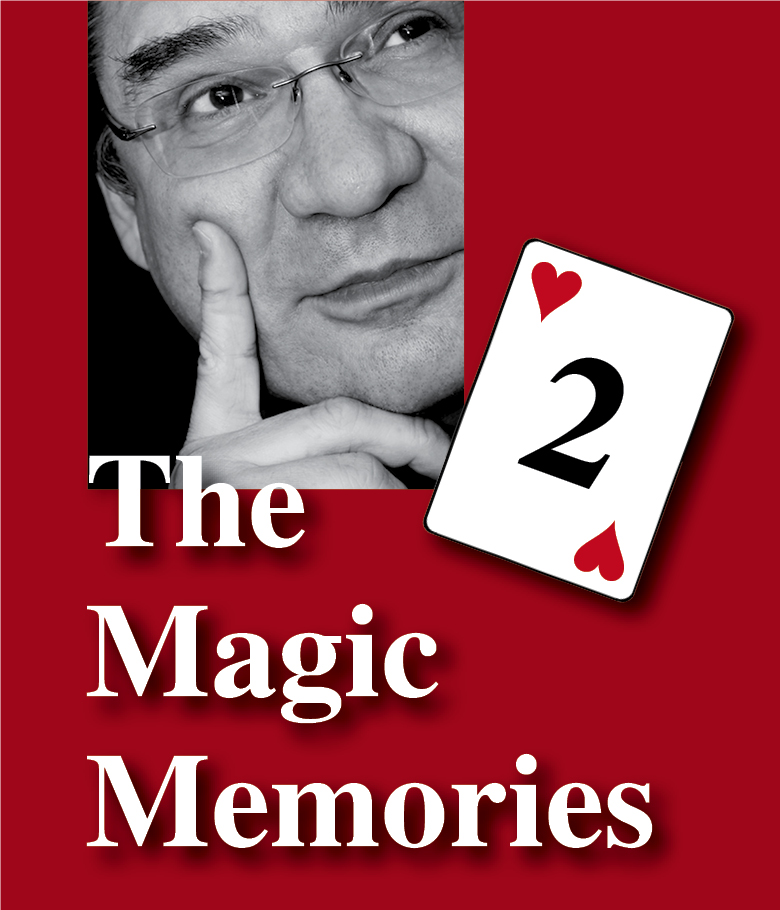
Hi everyone!
Here are The Magic Memories #51, gone online SUN, 19th December, at 0:07h.
How about a little card trick for today’s post?
Stabbed – Twice! (Dai Vernon)
On SUN, 14th FEB 2016 I had the pleasure and honor of performing at Werner Nussbaumer’s 90th birthday. In a conversation following the show he told me he had seen Dai Vernon do the following effect:
The performer takes a card from the deck and places it face up on the table, saying he will later use it as a “magic card”. The deck is shuffled, and then ribbon spread face down on the table. Two spectators each take a card, look at them, and replace them in the deck, which is then shuffled once more. The deck is ribbon-spread face down on the table, the initially discarded card is taken and thrown face up into the spread, or the spectator may take the card and insert it anywhere in the spread: the cards next to the inserted “magic card” prove to be the two previously chosen cards.
That’s the effect.
One of the very first magic books I read when I had discovered magic in a public library at age fourteen was Die Kunst, mit Karten zu zaubern (1969) – The Art of Performing Magic with Cards – what a lovely title. In this marvelous book the author Hanns Friedrich would describe the effect in colorful words, and then, instead of immediately giving the explanation, inserted a large sub-title:
DENKPAUSE (PAUSE TO THINK)
What a great idea! At that time, with almost no previous knowledge nor skill, my imagination went wild, and most of the time I imagined solutions that were either impossible or more complicated than spherical trigonometry, which I did not know either. In any case, Nussbaumer told me that Vernon was using two sets of 26 duplicates, separated at the beginning. He would ribbon-spread the cards and have a spectator on each side of the spread take a card, and then replaced it in the same half. He followed with a Perfect Faro to alternate the cards. Cutting the deck exactly in half, which really is the greatest difficulty to overcome when you do a Perfect Faro, isn’t difficult at all in this case, because when you hold the deck in readiness for the Faro Shuffle (see fig. 1 on p. 687 of Card College Volume 3), you can comfortably see the indexes you riffle off your right thumb (provided you’re right-handed). Then you simply stop at the first card of the second set, done. The Faro Shuffle itself is as easy as pie, and with the correct instruction (Card College 3! you’ll be able to acquire the knack within a few minutes, and then you can instill the skill after a very short time of regular practice.
Back to the trick: The deck can now be false shuffled with any false shuffle that keeps the cyclical arrangement of the cards. Eventually have the spectators give the deck several complete cuts. When you then recall what has been done, you can say, “The deck was shuffled and cut several times”, thereby gesturing toward the spectators who did the cut. This will reframe the situation, alter their memory and convince them that THEY shuffled AND cut. For those who are interested in the theory of this: We are applying here the “Principle of Recap” (Sharing Secrets, p. 86), “Memory Editing” (SS, p. 74), “Reframing” (SS, p. 92), “Initial & Final Situation” (SS, p. 50), and as almost always in such cases “The Midwife Theory” (SS, p. 76). It keeps fascinating me how such apparently simple procedures harbor such incredible complexity. I really recommend you dive into these aspects of magic, as the understanding of them will be intellectually and emotionally immensely rewarding, and will have a decisive impact on the quality of your performance (but even if you don’t perform, and maybe even more so, you will access another level in your magical affinity).
Ok, back again: When the spectator inserts the Joker face up into the deck, or even more spectacular if you throw your “magic card” into the spread, the cards to the left and to the right of it must be the two selections.
I had heard (or maybe read?) of this before Nussbaumer told me, but can’t remember where.

In many years of performance experience I can tell you that nobody (except a “magician”) will want to see the deck, provided you’ve performed this correctly. However, I’m told there is a guy out there who wrote a book solely on deck switches (if my memory serves me right it is called The Art of Switching Decks), so you can switch the special deck in and out. And yes, you can do it by using the same deck switch twice, once to get the cold deck in, once to get it out. The deck switch I’m talking about is called “The Joker Deck Switch” (p. 87), to wit: When you start with a straight deck (with a set-up, please), take out the Jokers and place them aside. Once you’ve done a few tricks put the deck back into the case and start to pocket it (switch), take it out and insert the Jokers into the “cold deck”. Place deck on table, converse a bit, or do a piece with another instrument. Then do “Stabbed – Twice!” as described above, initially placing the Jokers aside as you had already done at the beginning; this confirms that it is the same deck, of course. When you’re done, nonchalantly case the deck and start to put it in your pocket (switch), remember once again that you “forgot” the Jokers (see how bad a memory gets with age…). At least that’s what I do, and it has fooled more than just one person in the know, let alone those not in the know (“real” audiences) 🙂
An Impromptu Handling of This Effect (Roberto Giobbi)
Now, what about those of you who do not do deck switches because they refuse to buy the above-mentioned book… Well, because it is Xmas time, here is my gift to those of you who want to achieve (almost) the same effect with an ordinary deck (may using Card College Playing Cards?). Impromptu version to follow:
Give the deck to a spectator for shuffling. When he’s satisfied, ask him to take out the Joker and leave it face up on the table. If your deck doesn’t have a Joker, do as Vernon did and designate your favorite card as a “magic card”; it would make sense here to use maybe a Jack or a Queen as “detective or secret agent cards”, or what have you.
Two cards are selected by two spectators and apparently lost in the deck, in reality controlled to the top and the bottom of the deck. A nice way of doing so uses “A Peek Control for Two Cards” (Card College Volume 1, p. 75). Or simply enter “control of two cards” in Denis Behr’s archives website, and be surprised what you get. You could also search “two-card controls” etc. (This clue alone is worth today’s blog, isn’t it?).
Give the deck a final cut, retaining a break. Convert the break to a step as you ribbon spread the cards face down on the table. The spot in the deck where the two selections meet, can now be recognized from your perspective, but will be invisible to your audience, who (hopefully) is not aware of the concept at use. See “The Master Grip” in Card College Volume 3 (p. 544), an truly excellent and practical (you can delay a set-up…) trick.
Hand the Joker to the first spectator and ask him to whisper the name of his card into the Joker’s ear. Take the Joker back, and “ride” it over the spread, saying that now that the Joker knows the card, he will try to find it. If Bicycle cards are used, this is a nice moment to use this as a sight gag.
Repeat for the second spectator.
Now for the magic: Snap the Joker, explaining that this calls the two selections. Snap it once again and explain that this gathers the two selections. “Drive” the Joker over the spread, explaining that this locates the two selections.
Insert the Joker face up at the step, but leave it outjogged for half of its length. Move all the cards to the left and to the right of the three-card-set aside. Have each spectator name his card, and then reveal the cards next to the Joker to be precisely these cards, one after the other, hesitating on the second for dramatization.
Yes, this is a short description, at least compared to those in my books and videos (!), BUT it is nonetheless full of details: Please give them your full attention if you intend to perform this effect, regardless of which version.
Wish you all a successful week!
Roberto Giobbi

